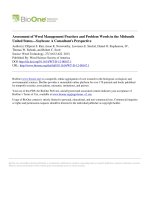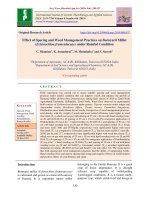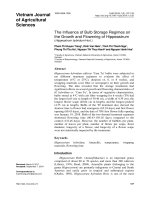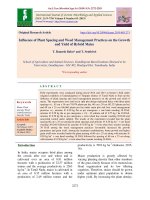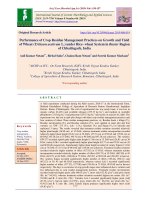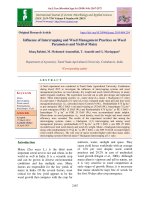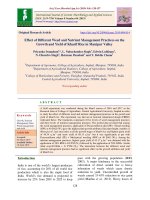Influence of plant spacing and weed management practices on the growth and yield of hybrid maize
Bạn đang xem bản rút gọn của tài liệu. Xem và tải ngay bản đầy đủ của tài liệu tại đây (312.67 KB, 12 trang )
Int.J.Curr.Microbiol.App.Sci (2019) 8(3): 2272-2283
International Journal of Current Microbiology and Applied Sciences
ISSN: 2319-7706 Volume 8 Number 03 (2019)
Journal homepage:
Original Research Article
/>
Influence of Plant Spacing and Weed Management Practices on the Growth
and Yield of Hybrid Maize
T. Ramesh Babu* and T. Senthivel
School of Agriculture and Animal Sciences, Gandhigram Rural Institute (Deemed to be
University), Gandhigram - 624 302, Dindigul Dist. Tamilnadu, India
*Corresponding author
ABSTRACT
Keywords
Maize, Plant
spacing, Weed
control practices,
Growth, Yield
Article Info
Accepted:
20 February 2019
Available Online:
10 March 2019
Field experiments were conducted during kharif 2014 and 2015 at farmer’s field under
irrigated condition at Udumalaipettai of Tiruppur district of Tamil Nadu to find out the
influence of plant spacing and weed management practices on the growth and yield of
maize. The experiments were laid out in split plot design replicated thrice with three plant
spacings viz., 45 cm x 30 cm (74,074 plants per ha), 60 cm x 20 cm (83,333 plants per ha)
and 60 cm x 25 cm (66,666 plants per ha) under main plot and four weed management
practices viz., atrazine @ 0.50 kg /ha as pre emergence + one hand weeding 30 DAS,
atrazine @ 0.50 kg /ha as pre emergence + 2,4 – D sodium salt @ 0.75 kg / ha 30 DAS,
atrazine @ 0.50 kg /ha as pre emergence + twin wheel hoe weeder weeding 30 DAS and
unweeded control under subplot. The results of the experiment revealed that the plant
spacing 60 cm x 25 cm among the plant spacings and atrazine @ 0.50 kg ha -1 + one hand
weeding 30 DAS followed by atrazine @ 0.50 kg ha-1 + twin wheel hoe weeder weeding
30 DAS among the weed management practices favourably increased the growth
parameters and grain yield. Among the treatment combinations, better growth and higher
grain yield were recorded under the plant spacing of 60 cm x 25 cm along with atrazine @
0.50 kg ha-1 + one hand weeding 30 DAS followed by spacing of 60 cm x 25 cm along
with atrazine @ 0.50 kg ha-1 + twin wheel hoe weeder weeding 30 DAS.
productivity is 7010 kg ha-1 (Indiastat, 201516).
Introduction
In India, maize occupies third place among
the cereals after rice and wheat and is
cultivated over an area of 8.81 million
hectares with a production of 22.57 million
tonnes and the average productivity is 2563
kg ha-1. In Tamil Nadu, maize is cultivated in
an area of 0.35 million hectares with a
production of 2.49 million tonnes and the
Maize production is greatly affected by
varying planting density than other members
of the grass family because of its monoecious
floral organization and its low tillering
cognition. Therefore, maize should be grown
under optimum plant population to obtain
higher yield. By increasing the plant density,
2272
Int.J.Curr.Microbiol.App.Sci (2019) 8(3): 2272-2283
yield per plant decreases but grain yield per
unit area increases. Exceeding beyond a
certain limit of plant density, yield is lost due
to increase in plant to plant unevenness and
increase in plant infertility as high plant
density above the certain level elongate the
duration between pollen shedding and silking
resulting in more unproductive plants (Ali et
al., 2017).
It is, therefore, suggested that recent maize
hybrids should be rather grown at optimum
communicate density for reduced competition
between the plants and to achieve higher
yields. It was found out that spacing
combinations of 65 x 25 cm responded
favorably in attaining higher grain yield of
maize (Getaneh et al., 2016).
Of the several factors are responsible for the
low yields of maize in India, the most critical
factor responsible for the low yield appears to
be the weed growth that competes with the
crop for nutrients, water, sunlight and space.
They cause yield losses worldwide with an
average of 12.8 per cent despite weed control
practices and 29.2% in case of unchecked
weed growth (Dogan et al., 2004).
Weeding has traditionally been a labour
intensive operation in crop production.
Manual weeding is seldom possible, because
of greater demand and high cost of human
labour. Pre- emergence application of atrazine
is the most beneficial one in maize weed
control compared to other chemicals for broad
spectrum weed control. Weed management
becomes more effective and economical when
it is integrated with both the mechanical and
chemical methods. Moreover, the late
emerging weeds in maize may have to be
controlled either chemically or by other
methods for better yield. Hence, keeping the
above points in view, an attempt was made to
study the effect of different spacings and
weed management practices on growth and
productivity of hybrid maize.
Materials and Methods
Field experiments were conducted at farmer’s
field, Udumalaiapettai, Tiruppur district of
Tamil Nadu during kharif 2014 and 2015 to
study the response of maize hybrids to varied
plant densities and weed control methods
under irrigated condition. The soil of the
experimental field was sandy clay loam in
texture. The nutrient status of soil during start
of the experiment was low in available
nitrogen (242.6 kg ha-1), medium in available
phosphorous (16.5 kg ha-1) and high in
available potassium (552 kg ha-1).
The maize hybrid, NK 6240 was chosen for
the study. The experiment was laid out in a
split plot design replicated thrice under
irrigated condition. Three plant spacings viz.,
45 x 30 cm (74,074 plants per ha), 60 x 20 cm
(83,333 plants per ha) and 60 x 25 cm (66,666
plants per ha) were the treatments under
mainplot. Four weed management practices
viz., Atrazine @ 0.50 kg / ha as pre
emergence 3 DAS + one hand weeding 30
DAS, Atrazine @ 0.50 kg / ha as pre
emergence 3 DAS + 2,4 – D sodium salt @
0.75 kg / ha 30 DAS, Atrazine @ 0.50 kg / ha
as pre emergence 3 DAS + twin wheel hoe
weeder weeding 30 DAS and Unweeded
control were fitted in subplot. The
observations on plant height, leaf area index
were taken and dry matter production
computed. Grain yield was recorded and
analysed statistically.
Results and Discussion
Plant height
The plant height, one of the important
morphological growth parameters showed a
positive influence at all the stages of crop
growth (Table 1). An increasing trend was
noticed in plant height from 30 to 90 DAS
and taller plants were observed under 60 cm x
20 cm initially upto 60 DAS and thereafter
2273
Int.J.Curr.Microbiol.App.Sci (2019) 8(3): 2272-2283
under 60 cm x 25 cm at later stages. The
plants were taller under the spacing of 60 cm
x 20 cm (higher population) than the other
spacings. This might be due to the higher
interplant competition for sunlight which
might have made the plants to grow taller to
trap more sunlight and it decreased with
increase in the plant spacing. This is clearly
evident from the tallest plants observed under
60 cm x 20 cm than 60 cm x 25 cm and 45 cm
x 30 cm plant spacing. Crop sown at closer
spacing normally exhibits higher plant height
than wider spacing as reported by Bangarwa
et al., (1989) is concomitant to the present
finding.
Zamir et al., (2011) reported that in normal
plant spacing there is abundance of available
resources and hence the plants were healthier
than thick plant stands. In narrow plant
spacing there was more competition for
available resources and hence plants were tall
but weaker than wider plant spacing.
Among the weed management practices, all
the treatments with atrazine recoded taller
plants than unweeded control. Taller plants
with broader leaf area might have
accumulated higher plant dry matter
consistently at all the growth stages of maize
with pre emergence application of atrazine 0.5
kg. Better weed control with favourable soil
environment might have resulted in reduced
crop weed competition for the growth factors
such as light, space and nutrients which in
turn helped in efficient photosynthetic activity
recording taller plants. From the experimental
results it is evident that high competition of
weeds reduced the input availability to plants,
thus reduced the plant height to a greater
extent. The plots having higher weed control
efficiency got more resources and produced
taller plants as earlier reported by Nadeem at
al. (2010). Unweeded control showed
significant reduction of plant height at all the
growth stages of the crop. These results are in
line with the findings of Singh and Singh
(2003) who reported that decrease in plant
height might be due to the fact that weed
suppressed the vegetative growth of plants by
competition for light, moisture and nutrients.
Efficacy of chemical or integration of
chemical with hand weeding or mechanical
weeding in controlling the weeds at critical
crop weed competition at 30 DAS in maize
might be the reason for the better growth of
maize under atrazine 0.5 kg + hand weeding
and atrazine + twin wheel hoe treatment..
Leaf area index
Leaf area index increased rapidly from 30
DAS to 60 DAS. LAI was significantly
influenced by different spacing and weed
management practices. The LAI increased
upto 60 DAS and then decreased. This
reduction might be due to the completion of
vegetative phase and entering into the
reproductive phase, causing senescence of
leaves at harvest. Similar decrease in LAI at
harvest stage was expressed by Verma and
Joshi (1999) (Table 2).
The LAI of corn was significantly higher at
60 cm x 25 cm than 60 x 20 cm crop
geometry. Wider space availability between
the rows and the normal intra-rows might
have increased the root spread which
eventually utilized the resources such as
water, nutrients, space and light very
effectively. Better utilization of available
resources might have increased the functional
leaves and in turn enhanced the LAI. This is
in conformity with the findings of Pandita et
al., (1998), Abo-Shetaia et al., (2002) and
Maddonni et al., (2006) in maize.
The importance of leaf area index (LAI) on
crop is well recognized. An increase in LAI
results in better utilization of solar energy.
Lesser weed competition resulting in higher
availability of plant nutrients and moisture
2274
Int.J.Curr.Microbiol.App.Sci (2019) 8(3): 2272-2283
favouring higher leaf area index and vigorous
crop growth of maize with pre emergence
application of atrazine 0.5 kg might be the
reason for higher LAI recorded under
treatments involving atrazine. Generally, the
leaf area index was higher in all weed control
treatments compared with that of unweeded
control. Similar result of higher LAI under
atrazine treatments reported by Shenbagam
(2011) is in support of the present findings.
the view of Kumar (2004) who observed that
effective control of weeds right from
germination of crop might have allowed the
crop to utilize the resources effectively and
this could be the reason for higher dry matter
production of maize. In general reduction in
nutrient removal by weeds through suitable
weed management practices enhanced the
nutrient uptake and dry matter production of
the crops as reported by Balasubramanian and
Veerabadran (1998).
Dry matter production (DMP)
The dry matter production (DMP) increased
steadily with time and age of the crop. At 30
DAS the DMP was less and at 60 and 90 DAS
a steep increase was noticed. This might be
due to rapid increase in plant height and leaf
area at these stages (Table 3 and 4).
Significantly higher DMP at respective stages
of the investigation was noticed under 60 cm
x 25 cm crop geometry. This might be due to
the utilization of available resources to a
greater extent that could have favoured the
LAI which in combination caused an increase
in DMP at 60 cm spacing as compared to
other spacings. Further, more availability of
sunlight and CO2 under wider spacing might
have resulted in higher photosynthetic
activities and ultimately higher production of
dry matter. The present findings are in
consonance with the reports of Chen et al.,
(1990) and Cox et al., (2006) in maize.
More plant dry matter production was
recorded under the treatments with pre
emergence application of atrazine 0.5 kg. This
might be due to better weed control by
optimum dosage of herbicide and either hand
weeding or mechanical weeding which
produced conducive environment favouring
higher uptake of nutrients that reflected on
higher leaf area index and better source sink
relationship for accumulating higher dry
matter. The findings are in accordance with
The interaction effect was significant at all the
stages. Higher DMP was recorded under the
spacing 60 cm x 25 cm with atrazine @ 0.50
kg ha-1 + one hand weeding on 30 DAS which
was on par with spacing 60 cm x 25 cm with
twin wheel hoe weeder weeding. The spacing
60 cm x 20 cm under weedy check recorded
lower amount of DMP at all the stages.
Grain yield
The data on the yield is presented in Table 5.
Crop geometry had a positive influence on
yield of maize. Maize grown at 60 cm x 25
cm spacing recorded higher grain yield than
others. This increase in yield was probably
due to effective utilization of applied
nutrients, increased sink capacity and nutrient
uptake by the crop. The yield potential of
maize is mainly governed by the growth and
yield components. The positive and
significant correlation of LAI and DMP
noticed at different stages, increased yield
attributes and nutrient uptake would have
resulted in enhanced cob yield. Paulpandi et
al., (1998) reported higher yield of maize
under wider row spacing due to better
availability of resources. The present finding
corroborates with the findings of Chen et
al.(1990)and Maddonni et al., (2006) in
maize. Sabo et al., (2016) concluded that the
intra-row spacing of 25 cm showed better
performance than 20 cm and 30 cm and this
result lend support to the present findings.
2275
Int.J.Curr.Microbiol.App.Sci (2019) 8(3): 2272-2283
Table.1 Effect of spacing and weed management practices on plant height of maize
Treatment
(Kharif 2014)
(Kharif 2015)
30
DAS
60
DAS
Harvest
30
DAS
60
DAS
Harvest
S1 - 45 × 30 cm (74,074 plants ha-1)
64.68
173.8
198.5
67.47
176.5
201.5
S2 - 60 × 20 cm (83,333 plants ha-1)
67.15
184.2
183.9
70.04
187.0
186.7
S3 - 60 × 25 cm (66,666 plants ha-1)
54.75
161.1
210.3
57.10
163.5
213.5
SEd
1.30
3.6
4.2
1.35
3.7
4.2
CD (P=0.05)
2.60
8.1
9.6
2.76
8.3
9.8
W1 - Atrazine @ 0.50 kg ha-1 as PE +
HW at 30 DAS
68.01
191.7
218.9
75.11
194.6
222.2
W2 - Atrazine @ 0.50 kg ha-1 as PE +
2,4-D Sodium salt @ 0.75 kg ha-1
at 30 DAS
66.82
177.2
202.3
66.92
179.8
205.3
W3 - Atrazine @ 0.50 kg ha-1 as PE +
Twin wheel hoe weeder at 30
DAS
67.23
184.4
210.5
68.72
187.1
213.7
W4 - Unweeded control
46.76
138.9
158.6
48.73
141.0
161.0
SEd
1.80
4.9
5.7
1.88
5.0
5.75
CD (P=0.05)
3.78
10.4
11.9
3.94
10.6
12.08
Interaction
NS
NS
NS
NS
NS
NS
2276
Int.J.Curr.Microbiol.App.Sci (2019) 8(3): 2272-2283
Table.2 Effect of spacing and weed management practices on leaf area index of maize
Treatment
(Kharif 2014)
(Kharif 2015)
30
DAS
60
DAS
Harvest
30
DAS
60
DAS
Harvest
S1 - 45 × 30 cm (74,074 plants ha-1)
1.57
4.92
3.97
1.60
4.97
4.04
S2 - 60 × 20 cm (83,333 plants ha-1)
1.45
4.56
3.68
1.48
4.61
3.74
S3 - 60 × 25 cm (66,666 plants ha-1)
1.66
5.22
4.21
1.69
5.27
4.28
SEd
0.03
0.10
0.08
0.04
0.10
0.09
CD (P=0.05)
0.06
0.22
0.18
0.09
0.23
0.20
W1 - Atrazine @ 0.50 kg ha-1 as PE +
HW at 30 DAS
1.67
5.43
4.38
1.76
5.48
4.46
W2 - Atrazine @ 0.50 kg ha-1 as PE +
2,4-D Sodium salt @ 0.75 kg ha-1
at 30 DAS
1.66
5.02
4.05
1.63
5.07
4.12
W3 - Atrazine @ 0.50 kg a.i. ha-1 as PE
+ Twin wheel hoe weeder at 30
DAS
1.66
5.22
4.21
1.69
5.27
4.29
W4 - Unweeded control
1.25
3.93
3.17
1.28
3.97
3.23
SEd
0.08
0.14
0.11
0.05
0.14
0.12
CD (P=0.05)
0.16
0.29
0.23
0.10
0.30
0.24
Interaction
NS
NS
NS
NS
NS
NS
2277
Int.J.Curr.Microbiol.App.Sci (2019) 8(3): 2272-2283
Table.3 Effect of spacing and weed management practices on dry matter production (kg ha-1) of maize (Kharif 2014)
Treatment
30 DAS
W1
W2
60 DAS
W3
W4
Mean
W1
W2
Harvest
W3
W4
Mean
W1
W2
W3
W4
Mean
S1
526.8 507.6
517.6
393.0
486.3 7376 7107
7247
5503
6808
14192 13675
13944
10588
13100
S2
498.2 443.8
471.7
388.7
450.6 6975 6213
6604
5442
6308
13421 11955
12707
10471
12139
S3
564.0 535.3
557.9
383.8
515.2 8176 7494
7810
5373
7213
15732 14420
15029
10339
13880
Mean
526.3 515.6
515.7
388.5
7509 6938
7220
5439
14449 13350
13893
10466
S
W
S at W W at S
SEd
10.2
13.9
23.2
CD(P=0.05)
22.4
29.1
46.7
S
W
24.0
143
194
325
47.9
298
408
682
2278
S at W W at S
S
W
S at W W at S
336
276
374
625
647
530
565
785
1313
1020
Int.J.Curr.Microbiol.App.Sci (2019) 8(3): 2272-2283
Table.4 Effect of spacing and weed management practices on dry matter production (kg ha-1) of maize (Kharif2015)
Treatment
30 DAS
W1
W2
60 DAS
W3
W4
Mean
W1
W2
Harvest
W3
W4
Mean
W1
W2
W3
W4
Mean
S1
536.4 516.8
527.0
400.2
495.1 7413 7143
7283
5530
6842
14263 13744
14014
10641
13166
S2
507.2 451.8
480.2
395.7
458.7 7010 6244
6637
5469
6340
13488 12015
12771
10524
12199
S3
564.6 560.0
568.0
390.8
524.6 8217 7532
7849
5400
7250
15811 14492
15104
10391
13950
Mean
526.0 514.5
525.1
395.5
7546 6973
7256
5467
14521 13417
13963
10519
S
W
S at W W at S
SEd
10.4
14.1
23.6
CD(P=0.05)
21.9
29.7
48.6
S
W
24.5
144
195
326
50.6
390
410
686
2279
S at W W at S
S
W
S at W W at S
338
277
376
628
651
533
389
789
1319
1025
Int.J.Curr.Microbiol.App.Sci (2019) 8(3): 2272-2283
Table.5 Effect of spacing and weed management practices on grain yield (kg ha-1) of maize
Treatment
(Kharif 2014)
(Kharif 2015)
W1
W2
W3
W4
Mean
W1
W2
W3
W4
Mean
S1
6591
5987
6493
4171
5811
6890
6475
6787
4394
6137
S2
6287
5709
6006
4125
5532
6570
5961
6274
4346
5788
S3
7198
6481
6920
4073
6168
7529
6785
7237
4291
6461
Mean
6692
6059
6473
4123
6996
6407
6766
4344
S
W
S at W
W at S
S
W
S at W
W at S
SEd
109
147
246
255
114
155
259
269
CD(P=0.05)
224
289
507
519
230
326
525
534
S1
:
Spacing
45 × 30 cm (74,074 plants ha-1)
S2
:
60 × 20 cm (83,333 plants ha-1)
W2
S3
:
60 × 25 cm (66,666 plants ha-1)
W3 : Atrazine @ 0.50 kg ha-1 as PE + Twin wheel hoe weeder at 30 DAS
W4 : Unweeded control
W1
Weed management practices
: Atrazine @ 0.50 kg ha-1 as PE + One hand weeding at 30 DAS
Atrazine @ 0.50 kg ha-1 as PE + 2,4-D Sodium salt @ 0.75 kg ha-1 at
:
30 DAS
2280
Int.J.Curr.Microbiol.App.Sci (2019) 8(3): 2272-2283
Among the weed management practices
studied, pre emergence application of atrazine
0.5 kg ha-1 in combination with hand weeding
30 DAS registered higher grain yield (6692
kg ha-1in 2014 and 6996 kg hya-1 in 2015,
respectively). The yield increase over control
is 69.0 % in 2014 and 61.0% in 2015,
respectively. Similarly the yield increase due
to atrazine 0.5 kg + twin wheel hoe weeder
weeding on 30 DAS and atrazine 0.50 kg ha-1
+ one hand weeding on 30 DAS was 57.0%
and 47% during 2014 and 55.8% and 47.5%
in 2015, respectively. The yield increase
could be attributed to the reason that herbicide
application might have killed the weeds at
germination phase avoiding competition for
crop growth from the inception of
germination of the crop and hand weeding on
25 DAS lasting its efficiency at later growth
stages. The results are in accordance with the
findings of Singh and Singh (2009) who have
observed that pre emergence application of
atrazine 0.5 kg ha-1 followed by one hand
weeding on 45 DAS produced maximum pod
and haulm yield of groundnut when compared
to farmer’s practice of hand weeding twice.
The results of Deshmukh et al., (2014) who
reported that the atrazine 1.0 kg ha-1 as PE
followed by mechanical / HW at 30 DAS
proves better in controlling weed, dry matter
accumulation, WCE, grain yield and net
monetary returns and Kakade et al., (2016)
who reported that sequential application of PE
and PoE herbicides i:e, atrazine 0.50 kg ha-1
followed by 2,4-D sodium salt 0.5 Kg PoE at
30 DAS proves better in controlling weeds
and found economical
compare to
conventional weed management practice in
maize lend support to the present findings.
The interaction between plant spacings and
weed management practices on maize grain
yield was significant. The treatment
combination of 60 cm x 25 cm with pre
emergence application of atrazine 0.5 kg ha-1
+ one HW 30 DAS recorded significantly
higher grain yield. In maize grown under 60 x
25 cm, there was little competition for various
resources except intra-species competition
and the immediate supply of nutrients might
be the reason for increase in growth and yield
parameters which would have increased the
yields in the treatments mentioned. Similar
result of higher maize yield under sole maize
along with pre emergence application of
atrazine 0.5 kg ha-1 + one hand weeding on 40
DAS as reported by Shah et al., (2011) lends
support to the present finding. The findings of
Abouziena et al., (2008) who reported that
sowing maize in 60 cm x 25 cm and
controlled weeds by one chemical produced
the highest grain yield is also in line with the
present findings.
From the results of the experiments conducted
it can be concluded that the plant spacing 60
cm x 25 cm among the plant spacings and
atrazine @ 0.50 kg ha-1 + one hand weeding
on 30 DAS followed by atrazine @ 0.50 kg
ha-1 + twin wheel hoe weeder weeding at 30
DAS among the weed management practices
favourably increased the growth parameters
and grain yield. Among the treatment
combinations, better growth and higher grain
yield were recorded under the plant spacing of
60 cm x 25 cm along with atrazine @ 0.50 kg
ha-1 + one hand weeding on 30 DAS followed
by spacing of 60 cm x 25 cm along with
atrazine @ 0.50 kg ha-1 + twin wheel hoe
weeder weeding at 30 DAS.
References
Abo-Shetaia, A.M., A.A. Abd-Elgawad, A.A.
Mohamed and T.I. Abd-Elwhab, 2002.
Yield dynamics in four yellow maize
(Zea mays L.) hybrids. Arab. Univ. J.
Agric. Sci., Ain Shams Univ., Cairo, 10:
205-219.
Abouziena, H.F., I.M. El-Metwally and
E.R.El-Desoki. 2008. Effect of plant
2281
Int.J.Curr.Microbiol.App.Sci (2019) 8(3): 2272-2283
spacing and weed control treatments on
maize yield and associated weeds in
sandy soils. American-Eurasian J.
Agric. Environ Sci., 4(1): 09-17.
Ali, A., M.E. Muhammad, M. Imran, R.
Qamar, A. Ali and B. Ali. 2017. Interand Intra- Row and plant spacing
impact on maize (Zea mays L.) growth
and productivity: A review. Internl. J.
Advanced Sci. and Res., 2 (1): 10-14
Balasubramanian, R. and V. Veerabadran.
1998. Continuous application of same
herbicides on weeds and grain yield of
lowland rice. Pestology. XXI (1): 26-28.
Bangarwa, A.S., M.S. Kairon and K.P. Singh.
1989. Effect of plant population and
nitrogen application on yield and
economics of winter maize. Indian J.
Agron., 34(4): 393-395.
Chen, C.C., C.S. Wang and D.J. Liu. 1990.
Effect of planting density and N
fertilization on the silage yield of maize.
J. Agric. Res. China, 39(1): 21-27.
(Cited: Maize Abstr., 1991, 7(3): 358).
Cox, W.T., J.J. Hanchar, W.A. Knoblauct and
J.H. Cherney. 2006. Growth, yield,
quality and economics of corn silage
under different row spacings. Agron. J.,
98:163-167.
Deshmukh,J.P., P.V. Shingrup, M.S. Dandge,
V.M. Bhale and A.N. Paslawar. 2014.
Integrated weed management in maize.
Biennial Conference of Indian Society
of Weed Science on “Emerging
Challenges in Weed Management”.
Directorate of Weed Science Research,
Jabalpur, Madhya Pradesh, India, pp-33
(81).
Dogan, M.N., A. Unay, O. Boz and F. Albay.
2004. Determination of optimum weed
control timing in maize (Zea mays L.).
Turk J. Agron., 28: 349-354.
Getaneh L, K. Belete and T. Tana. 2016.
Growth and productivity of maize (Zea
mays L.) as influenced by inter and intra
row spacing in Kombolacha, Eastern
Ethiopia. J. Bio. Agri. Healthcare.
6(13):90-101.
Indiastat. 2015-16.
Kakade, S.U., J.P. Deshmukh, V.M. Bhale,
M.S. Solanke and P.V. Shingrup. 2016.
Efficacy of pre and post emergence
herbicides
in
Maize.
Extended
Summaries Vol. 1: 4th International
Agronomy Congress, Nov. 22–26,
2016, New Delhi, India. pp - 442-443.
Kumar, G.P. 2004. Evaluation of early post
emergence herbicide for control of
weeds in cotton and its effect of its
residue on crops grown in sequence.
Ph.D. Thesis, Tamil Nadu Agricultural
University, Coimbatore, Tamil Nadu,
India.
Maddonni, G.A., A.G. Cirilo and M.E.
Otegui. 2006. Row width and maize
grain yield. Agron. J., 98: 1532-1543.
Nadeem, M.A., M. Awais, M. Ayub, M. Tahir
and M.M. Maqbool. 2010. Integrated
weed management studies for autumn
planted maize. Pakistan J. Life Soc.
Sci., 8(2): 98-101.
Pandita, A.K., M.H. Shah and A.S. Bali.
1998. Row ratio in maize (Zea mays) +
legume intercropping in temperate
valley condition. Indian J. Agric. Sci.,
68(10): 633-635.
Paulpandi, V.K., U. Solaiyappan and S.P.
Palaniappan. 1998. Effect of plant
geometry and fertilizer levels on yield
and yield attributes in irrigated maize.
Indian J. Agric. Res., 33(2): 125-128.
Sabo, M.U., M.A. Wailare, M.J. Aliyu and
Sanusi. 2016. Effect of variety and
spacing on growth and yield of maize
(Zea mays L.) in Bauchi State, Nigeria.
Int. Plant and Soil Sci., 9(6):1-6.
Shah, S.N., J.C. Shroff, R.H. Patel and V.P.
Usadadiya.
2011.
Influence
of
intercropping and weed management
practices on weed and yields of maize.
Intl. J Sci., and Nature. 2(1): 47-50.
Shenbagam, K. 2011. Studies on integrated
2282
Int.J.Curr.Microbiol.App.Sci (2019) 8(3): 2272-2283
weed management practices in maize.
M.Sc (Ag) Thesis, Tamil Nadu
Agricultural Univ., Coimbatore, Tamil
Nadu, India
Singh, A.P. and P.C. Singh. 2003. Effect of
different weed control methods on
growth and yield of rabi-sown maize
cv. Hybrid 4640. J. Living world. 10(2):
12-15.
Singh, H. and S. Singh. 2009. Weed
management and soil microorganisms
studies in irrigated summer groundnut
(Arachis hypogaea L.). Indian J. Weed
Sci., 41 (1&2): 103-107.
Verma, S.K. and Joshi, V.P. 1999. Effect of
nitrogen and seedrate on leaf area index,
nitrogen content, nitrogen uptake and
dry matter yield of Teosinte at different
growth stages. Maize Abstr., 15(1): 162.
Zamir M S I, A.H. Ahmad, M.H.R. Javeed
and T. Latif. 2011. Growth and yield
behaviour of two maize hybrids (Zea
mays l.) towards different plant spacing.
Cercetări Agronomiceîn Moldova.
2(146): 33-40.
How to cite this article:
Ramesh Babu, T. and Senthivel, T. 2019. Influence of Plant Spacing and Weed Management
Practices on the Growth and Yield of Hybrid Maize. Int.J.Curr.Microbiol.App.Sci. 8(03): 22722283. doi: />
2283
